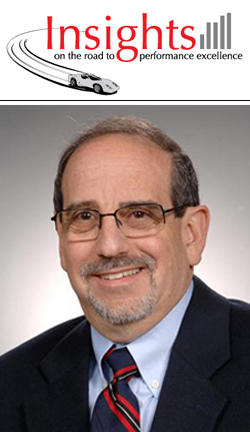Are You Lighting Fires or Getting Burned?

Dr. Harry Hertz, Director Emeritus
Baldrige Performance Excellence Program
December 2010
The 2011–2012 Criteria for Performance Excellence have just been released. One new concept introduced is "intelligent risk." While it is mentioned only in item notes and item descriptions, I believe it is an important concept for all leaders and all organizations to consider as a key factor in organizational sustainability. It is essential in achieving innovation. As a matter of fact, in a study of innovative organizations conducted 20 years ago, Charles Hampden Turner reported (Charting the Corporate Mind, New York: The Free Press, 1990, p. 17) that managers identified two critical elements for innovation: (1) support for risk taking and change and (2) tolerance of mistakes.
The lesson from this study and others is that discouraging risk taking and potentially rewarding risk avoidance (an unconscious practice of many organizations) also discourages and hampers innovation and progress. Properly encouraged, risk is thus a source of opportunity and sustainability—not, as many think, a source strictly of potential danger. Hence, the concept of intelligent risk becomes important to organizational sustainability and to an organization's senior leadership as a sustainability factor.
A good operational definition of an intelligent risk might be "an opportunity where the potential gain outweighs the harm or loss that could impact the organization's sustainability if the opportunity is not explored." Inherent in the concept is a strategic decision on resources to commit and also knowing if the risk has reached a point in exploration where more resources should be committed or resources should be pulled because results indicate that the harm may now be greater than the benefit. Of course, the organization can never reach this point if it is so averse to risks that it never makes the initial commitment.
This brings me to my title for this post and "lighting fires"! A simple analogy for intelligent risk is how one considers fire. If individuals avoid fire completely (being risk-averse), they will have a cold home, cold showers, and lots of cold food. If they use fire effectively (taking an intelligent risk), it will make their lives better and more comfortable. If they use fire recklessly and in an uncontrolled fashion (taking an unintelligent risk or being a daredevil), they will get burned and lose their assets. Can you find your organization's position on the "fire scale"?
Hopefully, this discussion has convinced readers that intelligent risk is a key to value creation. But where does intelligent risk end and organizational daredevil behavior begin? How much risk is it intelligent for an organization to take? Are you prepared to take intelligent risks? I believe the answers to these questions depend on numerous factors. Here are some of the factors I would consider:
How much risk is the organization able to take, and how much is it actually taking currently?
Are you in a technology- and innovation-driven industry where survival depends on significant investment?
Are you in an industry where being the innovator would clearly set you apart?
Would a lack of innovation and risk taking harm the sustainability of your organization?
Do you have an innovation process and talent that is nurtured to take the risk?
Do you understand your market position and market potential? What is needed to grow or sustain your position or potential?
Do you have the risk management structure to oversee and control resource allocation?
Do you communicate with customers, suppliers, and partners and know their trajectories?
Is your organization regularly getting burned by stretching resources? Is that stretch necessary for survival?
Is your organization "eating cold food" and frozen in place? Will you be frozen out of the marketplace in the future?
I am sure my list is not exhaustive. I will give people an opportunity to share their thoughts in an upcoming Blogrige entry. Please give the topic some thought and contribute to a dialogue.
Let me conclude this month's column by promoting an intelligent risk I believe all organizations should take (actually, there is no risk involved). That is, become active in your state or local Baldrige-based program or the Baldrige Program by having someone in your organization serve as an examiner, and bring that knowledge back to your strategic planning process. The online application for becoming a Baldrige examiner is now open.
Finally, let me wish everyone a happy holiday season and a healthy, prosperous, and insightful New Year!
Resources
Baldrige Excellence Framework
Baldrige Excellence Builder
Blogrige
News
Sustainability Is Synonymous with Change (April 2010)
Mind Your “P’s” and “Q’s”: Personal Learning at the Quest for Excellence (May 2010)
It Is June 2010: Do You Know Where Your Board Is? Are Members Doing Their Homework? (June 2010)
Leading at the “Leading Edge of Validated Management Practice” (July 2010)
Engaging Employees in Challenging Times (August 2010)
September Is Back-to-School Time, and We Can All Learn to Communicate Better (September 2010)
Simplify Complexity, Please! (November 2010)
Archived Columns
You need to have Acrobat Reader installed on your computer to view the PDF file. If you do not have Acrobat Reader installed on your computer, download the program at http://get.adobe.com/reader. People with visual disabilities can download tools and information at http://www.adobe.com/accessibility to help make Adobe PDF files accessible.
Contacts
-
Baldrige Customer Service(301) 975-2036NIST/BPEP
100 Bureau Drive, M/S 1020
Gaithersburg, MD 20899-1020

